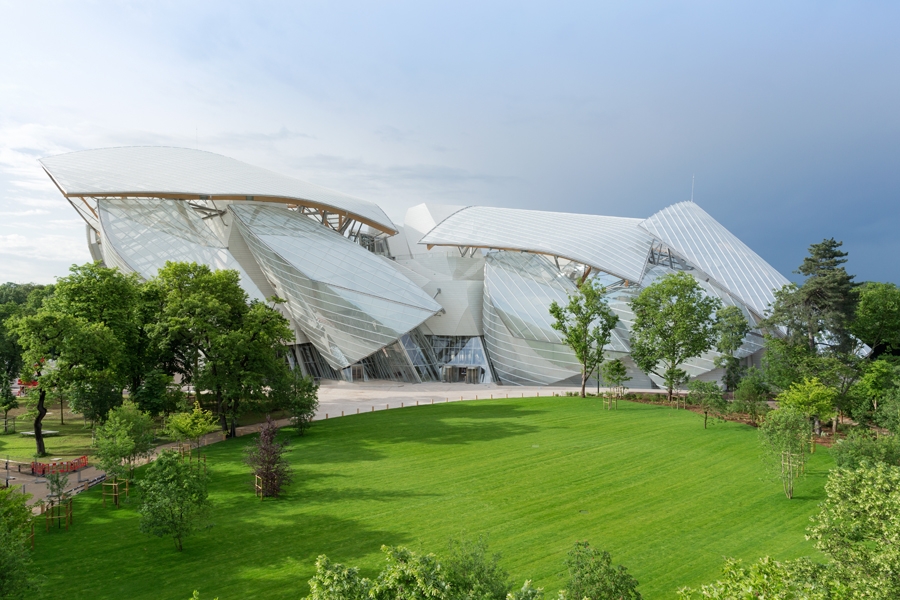How much can something grow before it outgrows itself? How much expansion is possible until things fall apart? Visiting the newly inaugurated Louis Vuitton Foundation in Paris’s lush Bois de Boulogne provoked many thoughts about expansionism, commercialism and bad art, and some feelings, primarily negative ones. It is described in French on the English website as ‘une nouvelle aventure culturelle’, a new cultural adventure. Or fairytale? In some languages, like Danish, an adventure (eventyr) is precisely a fairytale.
Frank Gehry’s vaguely organic-looking building is truly spectacular. With its many peculiar spatial setups, dwindling staircases, odd balconies and curved windows (who will clean them, and how?) it resembles a funhouse at an amusement park. Art itself is present as yet another kind of attraction, as something by which to be impressed and entertained.
There are two crucial aspects here: scale and make-believe. Everything is oversize, even the artworks are blown-up to fit in both with the large scale of the exhibition spaces and the expectations of the attention economy. And it is about a fairytale-style approach to what is at hand. It is Marie Antoinette busy with her socialising and fussing over her pets on the brink of the Revolution, Tsar Nicholas II ordering ever more Fabergé eggs while the uprisings begin. It is romantic and regressive, exaggerated and escapist. No wonder, then, that the artworks are treated as crown jewels in a theatrical treasury connected to different members of a royal entourage.
There is no context, neither historical nor contemporary, neither art-specific nor social, neither political nor economic. There is also no form of embracing what has been selected and combined outside of an attempt at canon-making. Canon-making as a method of writing history, as a method of curating and as a principle of running an art institution is far from a new phenomenon. It has been known in various forms since Giorgio Vasari’s Lives of the Most Excellent Painters, Sculptors and Architects (1550), an amusing piece of writing that is not devoid of fairytale-like accounts of the lives of the ‘creatives’ of the Renaissance. However, with the boom of the commercial art market and its need for legitimacy and promotion, canon-making has regained new strength and influence. The most surprising part of the story is that this way of working is nowadays employed by some of the recent past’s most pronounced supporters of deconstruction and its critique of grand narratives, master discourses and other power hierarchies.
But as this place is a funhouse, there is a strong suspicion that the crown jewels must be fake. The royal patrilineage quickly reveals itself as a blunt and anachronistic form of creating a narrative. Descending yet another staircase, and catching a glimpse of water falling on wide steps, I suddenly remember the amusements in the royal parks of St Petersburg. Peter the Great, Catherine the Great and the other rulers of Russia excelled in commissioning awesome and charming waterfalls, fountains and other games. The most skilled engineers and inventors of their time helped to construct costly wonders for the pleasure of the royals, not unlike how Gehry’s technical solutions are highlighted here.
It is not at all about patronage but about speculation and accumulation and preservation of capital, the philosophers argue, and they are of course right
So decadent-looking is the luxury goods-reliant Louis Vuitton Foundation that even the nestors of philosophy have raised their voices. Giorgio Agamben, Jean-Luc Nancy and Georges Didi-Huberman among others just published an article in Mediapart where they argue that the critical voices in art have also been bought by the wealthiest companies in France, which now compete for influence over the conditions of artistic production. It is not at all about patronage but about speculation and accumulation and preservation of capital, the philosophers argue, and they are of course right. The owners of these companies not only want to dominate our work, they also want to control our attention. And this current symbiosis between capital and the media, the authors contend, is only possible because the artists have allowed their work to be absorbed and become ‘designed’ art.
What puzzles me most is not that the artists agreed to be part of this funhouse – most of them are not that interesting or sophisticated in the first place – but that the Arnaults and Pinaults of the world are so conformist and uninventive. About to leave the Gehry building, I realise that there is a real fairytale that might say something about this: Jack and the Beanstalk. When Jack’s widowed mother asked her son to sell their only cow (as it no longer produced milk), he instead exchanged it for some magic beans offered to him by a stranger. The beans grew fast, stretching above the clouds, where they reached the palace of a rich giant. Jack climbed the beanstalk, and aided by the giant’s wife, he took some of the giant’s riches. Discovering the theft, the giant chased the boy, who was faster and managed to cut down the beanstalk, thereby killing the giant and living happily off the loot forever after. The question is: who is Jack in our tale?
This article was first published in the December 2014 issue.
